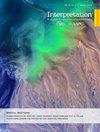USING SYNTHETIC DATA TRAINED CONVOLUTIONAL NEURAL NETWORK FOR PREDICTING SUB-RESOLUTION THIN LAYERS FROM SEISMIC DATA
IF 1.1
4区 地球科学
Q3 GEOCHEMISTRY & GEOPHYSICS
Interpretation-A Journal of Subsurface Characterization
Pub Date : 2023-02-08
DOI:10.1190/int-2022-0059.1
引用次数: 0
Abstract
Numerous studies have demonstrated the capability of supervised deep learning techniques for predicting geologic features of interest from seismic sections, including features that are difficult to identify using traditional interpretation methods. However, the successful application of these techniques in practice has been limited by the difficulty of obtaining a large training data set where the seismic data and corresponding ground truth labels are well-defined. Manually creating large amounts of labels requires a heavy workload, and the uncertainty of the interpretation and labeling process decreases the model’s ability for making accurate predictions. Using the chalk-flint sequence scenario onshore Denmark as an example, we have developed a novel workflow for predicting subresolution thin layers from seismic sections. It entails generating large quantities of synthetic training data with high-quality labels using stochastic geologic modeling, training a convolutional neural network based on the synthetic data set, and applying it to real seismic data. This is, to our knowledge, the first example of using deep learning to predict subresolution thin layers from seismic data based on geostatistically generated training images. It is shown that a neural network trained on synthetic data can predict a realistic number of subresolution flint layers from the real seismic data that have been collected from the Stevns region in Denmark, which has value for the understanding of the overall geologic characteristics of succession and engineering applications such as construction site evaluation.利用合成数据训练的卷积神经网络预测地震资料中的亚分辨率薄层
许多研究已经证明了监督深度学习技术从地震剖面中预测感兴趣地质特征的能力,包括使用传统解释方法难以识别的特征。然而,这些技术在实践中的成功应用受到了获得大型训练数据集的困难的限制,其中地震数据和相应的地面实况标签是明确定义的。手动创建大量标签需要繁重的工作量,并且解释和标记过程的不确定性降低了模型进行准确预测的能力。以丹麦陆上白垩-燧石序列为例,我们开发了一种从地震剖面预测亚溶解薄层的新工作流程。它需要使用随机地质建模生成大量具有高质量标签的合成训练数据,基于合成数据集训练卷积神经网络,并将其应用于真实地震数据。据我们所知,这是第一个使用深度学习根据地质统计学生成的训练图像从地震数据预测亚分辨率薄层的例子。研究表明,在合成数据上训练的神经网络可以从丹麦Stevns地区收集的真实地震数据中预测实际数量的亚溶解燧石层,这对理解演替的整体地质特征和工程应用(如施工现场评估)具有价值。
本文章由计算机程序翻译,如有差异,请以英文原文为准。
求助全文
约1分钟内获得全文
求助全文
来源期刊

Interpretation-A Journal of Subsurface Characterization
GEOCHEMISTRY & GEOPHYSICS-
CiteScore
2.50
自引率
8.30%
发文量
126
期刊介绍:
***Jointly published by the American Association of Petroleum Geologists (AAPG) and the Society of Exploration Geophysicists (SEG)***
Interpretation is a new, peer-reviewed journal for advancing the practice of subsurface interpretation.
 求助内容:
求助内容: 应助结果提醒方式:
应助结果提醒方式:


